Kanji Vada recipe, in which, Rai ka Pani is fermented along with lentil Vadas in it. This sour and tangy drink is a delicacy on Holi and an excellent probiotic drink. It's surprising that plain water with some spices tastes so delicious.
It's a specialty of North India especially Uttar Pradesh and Rajasthan. You can easily find vendors on the streets selling this in big earthen pots.
What is Kanji?
Kanji is nothing but fermented water. It is not only tangy & delicious but is therapeutic too. In fact, Kanji is an Indian probiotic drink that is excellent for digestion too.
The plain water is naturally fermented by adding mustard seeds powder. Except for salt, all other spices like chili powder asafoetida, cumin powder are optional and depend on individual preferences.
Anything can be added to this Kanji be it veggies or Vada made with lentils. Instead of Vada, at times we add carrots/ radish/ potatoes to it and even then it tastes yummy. However, adding Vadas make it exotic.
Kanji Vada for Holi
I really love our culture and the traditions associated with it. Each and every festival is associated with something specific having a significant relevance attached to it. Modak on Ganesh Chaturthi, Til Chikki on Sankranti, Paag on Janamashtmi, Sweets on Diwali, and so on.
And Holi is incomplete without Thandai, Gunjia, Kanji Vada, and Dahi Vada!
About 10 days prior to Holi, these preparations are in full swing. As I make Gunjias, my sons get an idea that Holi is about to come.
Must-Try for Holi:
- No-Cook Dahi Vada
- Ram Ladoo
- Papdi Pizza
- Sugar-free Thandai using Homemade Thandai Powder
- Thandai Panna Cotta
How To Make
But the recipe for this simple drink varies from person to person, region to region and thus no fixed recipe for making it. Some make Vadas with Urad dal, others with Moong dal whereas some prefer mixing both the lentils. Similarly, some people like to add lots of spices o the Vadas whereas others prefer plain vada.
I am sharing here my way of making Kanji Vada, the way it is made in our families.
- For Kanji Vada, we first prepare Vadas using both split black gram (Urad Dal) and Split Green Gram (Yellow Moong Dal).
- The two lentils are soaked for a few hours, then ground into a paste.
- Thereafter, Vadas are fried with this batter.
- And lastly, these Vadas are added to water along with spices. Then these are left for about a week during which the water gets tangy as it ferments and this sourness is equally transferred to the Vadas in it.
- Thus the plain Vadas now taste flavored.
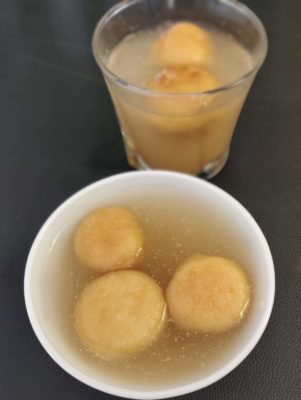
Oil-free Kanji Vada
Benefits
As I said in the beginning that this kanji water is an excellent probiotic drink. It is only good in taste but is full of medicinal values too.
- It detoxifies the liver
- It is excellent for digestion.
- This is a much-preferred drink in Ayurveda. Read here to know about its benefits in Ayurveda.
Step By Step Recipe
- First of all. soak the lentils for 3 to 4 hours. If the weather is cool, then soak it a little longer, maybe up to 6 hours.
- When the lentils are properly soaked, they will not only swell but will easily break into 2 when pressed between the fingers.
- Now, drain off the excess water and grind these lentils into a fine paste. Add very little water, if required, while grinding.
- Beat the batter for 3 to 4 minutes either with hands or an electric beater or whisk. The batter will become fluffy which in turn will lead to soft Vadas.
- Heat oil in a pan. When the oil is very hot, lower the flame and fry Vadas in it.
- Fry all the Vadas and keep them aside.
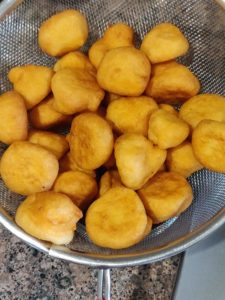
Tip: Make little extra Vadas and enjoy Ram Ladoo. Though the recipe is slightly different but you can very well use these vadas also.
- Take enough water in a wide pan and soak Vadas in it.
- After about 15 minutes, remove the Vadas by squeezing them with both hands.
- You will be surprised to see the quantity of oil floating on the water.
- Repeat the process. See the oil after the second soak. If not done this oil would have got in the kanji.
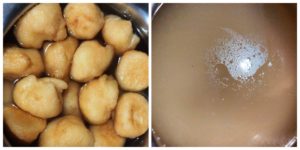
See the change in the Vadas after soaking in water twice
- Now, in a 2-liter jar, fill 1 litre of water. This is because we will be adding Vadas too.
- Add spices and mix.
- Gently add the squeezed Vadas.
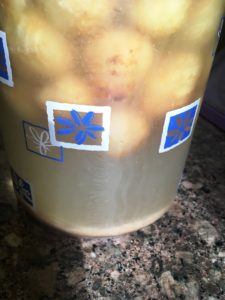
- Cover the lid. If possible, keep this jar in sunlight or at a warm place in your kitchen.
- Stir it daily but very carefully taking care that the Vadas are not broken. It is better if you use a wooden ladle. Just insert it inside the jar and stir lightly.
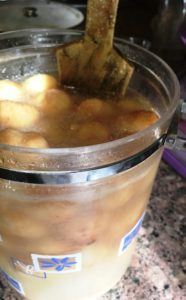
- It gets ready in 3 to 4 days depending on the weather. In winter, it takes up to a week also. You know it is ready when mustard seeds powder floats on the top and it tastes tangy.
- At the time of serving, stir it, put one or two Vadas, and lots of kanji (fermented water)
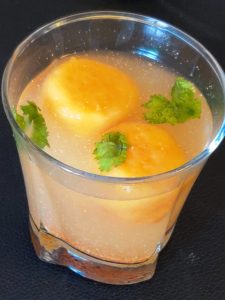
Serving Suggestions
- For making it spicier, add little green chutney at the time of serving.
- at the time of serving, add little Boondi along with Vadas.
FAQs
Q) When the fried Vadas are added to the water, doesn't the oil float on the top?
The answer is NO. A good Kanji does not have even a single trace of oil despite the fried Vadas in it. At my place, no one relishes the kanji with oil floating atop.
Q) How to ensure that my Kanji remains oil-free?
- To ensure this, the fried Vadas are first soaked in plain water. All the oil gets into this water.
- Then the Vadas are squeezed, removing the excess water.
- And then these Vadas are put in the Kanji water.
- I repeat the process twice to ensure that my Kanji remains oil-free.
Q) How do you know that Kanji is ready to drink?
You know it is ready when mustard seeds powder floats on the top and it tastes tangy.
LET’S CONNECT
Hope you liked this Kanji Vada recipe and will surely try it out for your loved ones. Do let me know through your comments. You know your feedback fuels my enthusiasm to post more good content. Let’s connect on Facebook, Pinterest, Instagram (#samirasrecipediary) too.
Kanji Vada Recipe
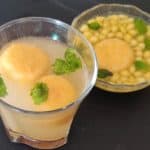
A delicious Indian probiotic drink.
For Vadas
- 3/4 Cup Yellow Moong Dal
- 1/4 Cup White Urad Dal
- A Pinch Asafoetida
- Oil For Frying
For Kanji
- 1 litre Water
- 3/4 Tbsp Salt
- 1 Tbsp Mustard Seeds Powder
- 1/4 tsp Red Chilli Powder
First of all. soak the lentils for 3 to 4 hours. If the weather is cool, then soak it little longer, may be up to 6 hours. When the lentils are properly soaked, they will not only swell but will easily break into 2 when pressed between the fingers.
Now, drain off the excess water and grind these lentils into a fine paste. Add very little water, if required, while grinding.
Beat the batter for 3 to 4 minutes either with hands or an electric beater or whisk. The batter will become fluffy which in turn will lead to soft Vadas. Do not beat too much, if the Vadas are too soft then they dissolve/break in the water and hence are not good.
Heat oil in a pan. When the oil is very hot, lower the flame and fry Vadas in it.
Fry all the Vadas and keep them aside.
Take enough water in a wide pan and soak Vadas in it.
After about 15 minutes, remove the Vadas by squeezing with both the hands. You will be surprised to see the quantity of oil floating on the water.
- Repeat the process.
- Now, in a 2 litre jar, fill 1 litre water. Add spices and mix. Gently add the squeezed Vadas.
If possible, keep the jar in the sunlight otherwise at any other warm spot in your kitchen. Stir it daily with light hands taking care that vadas do not break.
After about 4 to 5 days, mustard seeds will swell and the water will taste tangy too.
To serve, put one or two Vadas in a glass/bowl and fill it with kanji (fermented water).
You can add little green coriander chutney for making it spicy.
Once ready, it remains good up to a week only thereafter the taste starts deteriorating. To increase its shelf life you can keep it in the refrigerator After it is ready.
- Kanji takes a minimum of 4 to 5 days to get properly tangy. In cold weather, it may take up to a week or a little more.
- Do soak the Vadas twice in plain water to get rid of all excess oil.
- Adjust salt as per your taste. Taste kanji after 3 to 4 days, if need be, add a little more salt.
- Be gentle while stirring kanji in the jar, taking care that the Vadas remain intact.
- I do not add spices or salt while making Vadas as they absorb it well while soaked in the kanji. However, you may add red chili powder, and other spices to it if you have a liking for it.
- Once the kanji gets ready and if the weather is hot then you can keep it in the refrigerator also.
Check out the Blogging Marathon page for the other Blogging Marathoners doing this BM#98
I had been thinking to post this recipe for long but somehow couldn't. Probably, I saved it for the Blogging Marathon only as this is my third-day entry in it under the Festival theme.

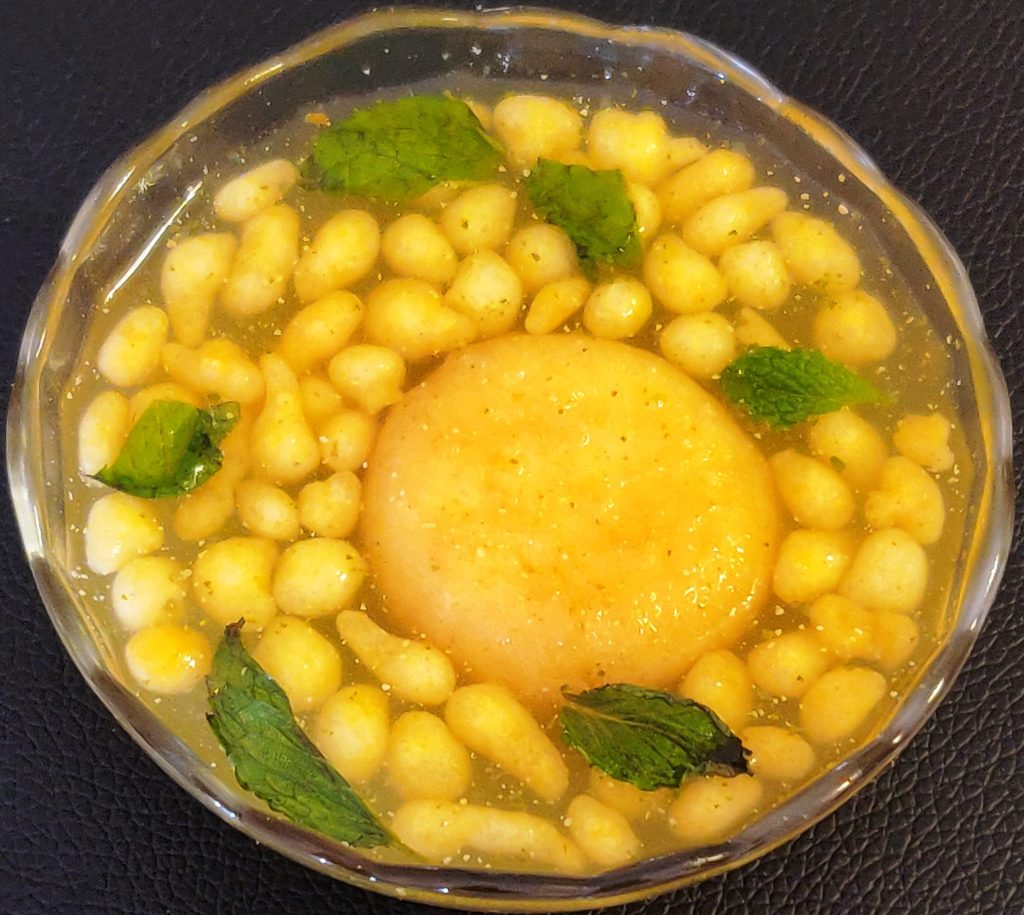

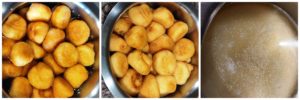


This recipe is new for me. The process of fermentation sounds very interesting.
Wow, i have heard about kanji with carrots and beets, this is a bit different, would love to give it a try!!! Nice share!!!
Thank you so much Priya. Do share your feedback once you try it out.
Use to be one of my favorites, not made since long. You are now tempting me to try this and specially when the summers are coming. They look droolicious.
Thank you so much. Though you must be aware but just reminding that keep it in the refrigerator in this weather.
It’s a very new recipe for me to try and looks so flavorful. Will give a try making this. Thanks for the recipe.
Thank you so much dear but in this weather try a very little quantity only and keep it in the refrigerator once it gets ready.
I have heard about this kanji vada but just now reading in detail on how they are made. Sounds very interesting. I am all for such fermented beverages. Thanks for sharing.
Glad you found it interesting.
I saw these in Delhi, but unfortunately couldn’t taste it. The process is so interesting. The vadas and the tangy kanji must both taste so yum.
Wow totally a new dish for me. Looks so delicious.
Thanks a lot. Try out a small batch with readymade boondi.
This is very interesting… haven’t heard of it as well… thank you for sharing…
It’s very common here in North India. If you have a liking for tangy drinks, then I suggest you try out in little quantity. Skip Vadas, you can even add readymade boondi.